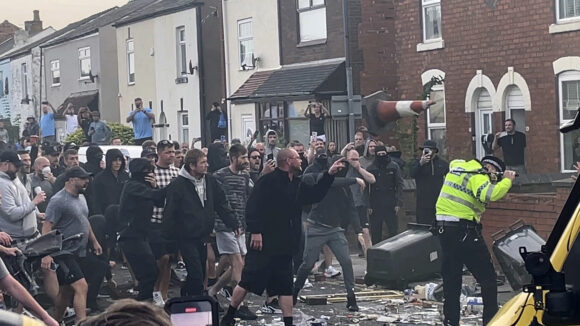Insured losses from recent riots in the United Kingdom are expected to remain at manageable levels with a limited impact on insurers’ credit profiles, according to credit agency Morningstar DBRS, in a market commentary.
The main reason for manageable claims is the UK Riot Compensation Act 2016 (RCA), which stipulates that single claims below £1 million (US$1.3 million) per property can be recovered from local police authorities, limiting overall losses for the British insurance industry to below £250 million (US$319 million), the report said.
Nevertheless, the UK riots “could negatively pressure the profitability of certain commercial line insurers depending on the extent businesses are affected,” said the report titled “Losses From Recent UK Riots Expected To Have a Marginal Impact on the British Insurance Industry.”
Geopolitical Risks: Why Underwriters Are Watching Aggregations
“We expect that British insurers will ultimately bear a relatively small portion of the total economic losses caused by the riots. We note, however, that business interruption losses resulting from vandalism, looting, and potential curfews, as well as large claims, are not covered under the RCA. Large companies and retail chains will likely rely on separate business interruption coverage under their commercial insurance policies,” the report said. (Economic losses include both insured and uninsured losses).
Growing SRCC Losses
The unrest in the UK will add to the concerns of providers of strike, riot, and civil commotion (SRCC) insurance and reinsurance globally, which have seen a rise in the frequency and severity of SRCC events over the past decade, said Morningstar, noting that these claims have prompted many insurance companies to reduce policy limits for these risks or drop the coverage altogether from standard insurance policies.
Large commercial clients have started to rely more on standalone SRCC insurance providers in the London market as well as global specialized reinsurers, the report said. “Nevertheless, even these providers have recently been limiting the risks they cover, particularly in traditionally volatile parts of the world.”
The costs of such events can be considerable. For example, economic and insured losses from just seven civil unrest incidents in recent years cost approximately $13 billion, said Allianz Commercial in a report published in April 2024.
The recent UK riots began on July 30 after a stabbing, which killed three children, was falsely blamed on an immigrant. The 17-year-old stabbing suspect was born in Britain.
Morningstar said these riots – which did cause major economic losses – may prompt traditional home and motor insurance providers to reconsider how they offer these coverages as part of their standard policies. (The report noted that SRCC cover is part of the specialized war, terrorism, and political violence insurance market, which provides coverages that complement those underwritten under standard motor, business, and homeowners insurance policies.)
Types of Coverage
The report went on to describe the types of policies that are available to provide coverage to help rebuild or replace assets damaged by episodes of vandalism and looting.
For instance, standard homeowners’ and motor insurance policies in the UK typically cover damages from vandalism, including fire, and looting, the report said. “Nonetheless, motor insurance policies that only cover third-party liability do not protect against physical damage, including any loss resulting from riots, civil commotion, or vandalism.”
The report explained that only all-risk or standard motor policies will cover physical damage, including damage from riots.
“In the UK, standard commercial insurance policies usually cover physical damage to the premises in the case of riots. Losses from looting might have a separate sub-limit if contracted. Glass coverage is also typically subject to separate limits and deductibles. These policies may also provide optional loss of income protection (business interruption or BI) for an additional premium.”
As BI coverage is only triggered by direct physical damage to the premises, some commercial clients may opt to get additional coverage under so-called “civil authority provisions,” which “provide protection for lost income and extra expenses if police or other civil authority bars access to the property, for instance in case of a curfew.”
UK Riot Compensation Act Explained
The Morningstar report said the UK riots will be a major test for the UK’s RCA, which was enacted in 2016 following the London riots of August 2011, when the insurance industry paid approximately £200 million (US$255.3 million) in claims.
Historically, local police authorities in the UK have been liable under statute to pay compensation to those suffering loss caused by riots – a principle that was codified in the Riot Act 1886, Morningstar recalled.
“However, the 2011 riots proved that the Riot Act 1886 was unfit for purpose in the modern world. For instance, it was unclear if damages to cars or losses from business interruption were covered, which triggered unnecessary litigation following the 2011 riots,” the report added. “The RCA simplified and clarified the procedure for claiming compensation from police authorities for property damage caused by riots.”
The RCA allows insurers, which have paid claims for riot damage, to subrogate and seek compensation from police authorities.
However, the RCA caps claims at £1 million per property and excludes coverage for BI losses, which means that most home and motor losses are covered by the RCA but any loss above £1 million are excluded by the RCA, the report explained.
“This compensation mechanism requires that victims of criminal damage or loss during a riot first file a claim with their insurers. If the claim is denied or the victim did not have insurance, then they can claim compensation under the RCA directly from the local policy authority,” Morningstar added.
“In order to qualify for compensation, victims must demonstrate that the damage or loss was as a result of a riot, and file a claim within 42 days from the date the riot ends,” the report said.
Photograph: An unruly crowd clash with police, Tuesday, July 30, 2024, in Southport, northwest England, near where three girls were stabbed to death in a dance class the day before. (Richard McCarthy/PA via AP)
Related:
Topics Profit Loss Claims
Was this article valuable?
Here are more articles you may enjoy.



 USI Says Lockton, Former Team Leader Poached Workers, Harmed Client Relations
USI Says Lockton, Former Team Leader Poached Workers, Harmed Client Relations  South Florida Insurance Broker Pleads Guilty to Fraud in $133M ACA Enrollment Scheme
South Florida Insurance Broker Pleads Guilty to Fraud in $133M ACA Enrollment Scheme  NC Committee Approves Bill to End Education Requirements for Insurance Agents
NC Committee Approves Bill to End Education Requirements for Insurance Agents  Wildfire Losses Drop Chubb Q1 Net Income 38%, While Tariffs Create ‘Confusion’
Wildfire Losses Drop Chubb Q1 Net Income 38%, While Tariffs Create ‘Confusion’ 

